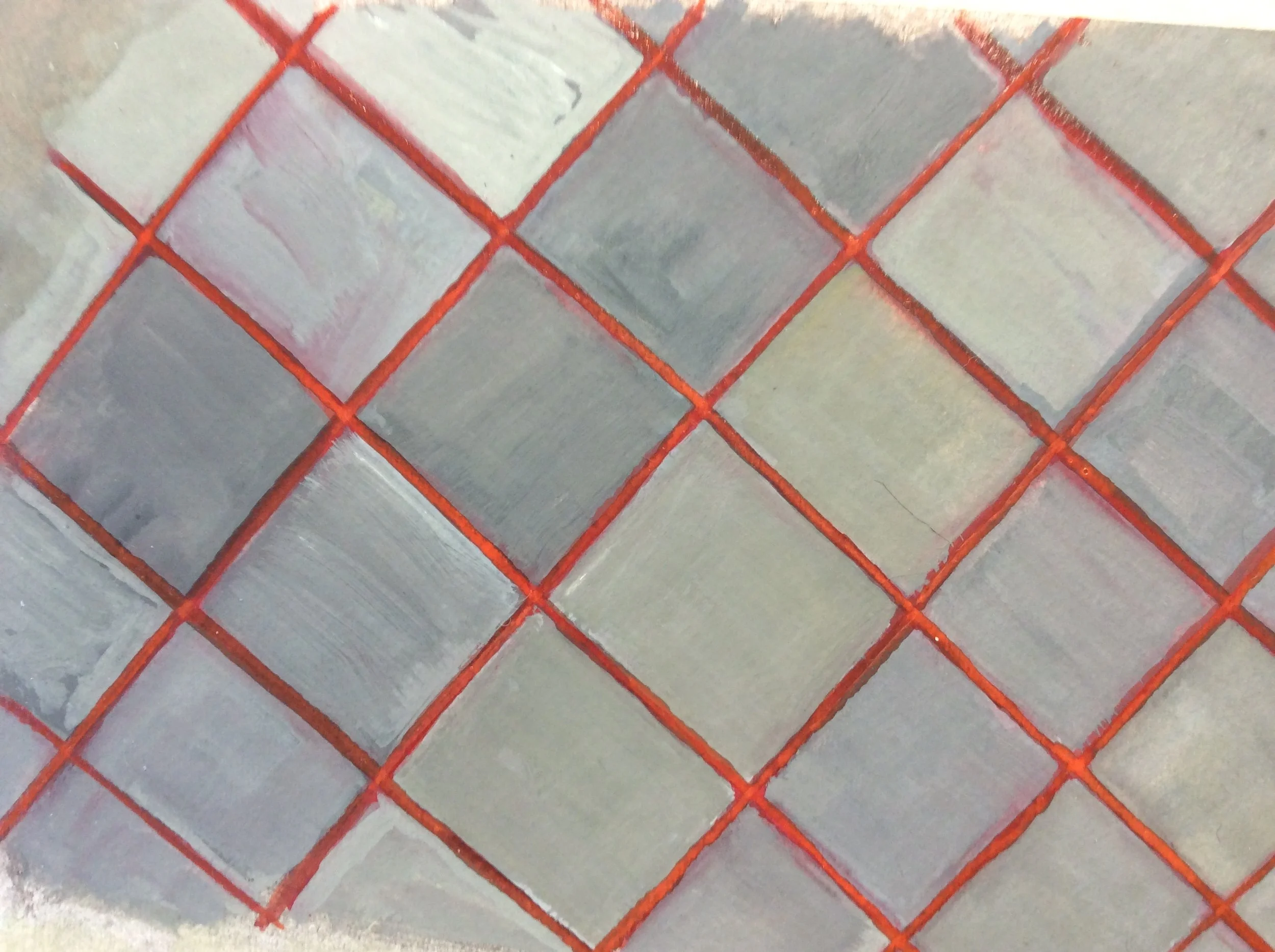Sidewalk color, seen in winter, Carolyn Prescott
Two instances of extreme seeing
A couple of weeks before Christmas, a day of bright sunshine broke our steady record of heavily overcast, foggy, and rainy days. I was facing the sun as I walked home from a morning appointment, my face turned up and eyes momentarily closed, enjoying the warmth. Then I opened my eyes and stared down at the gray diamond-patterned sidewalk—when suddenly the lines between the pebbled cement blocks rose up in glowing red. I say rose up because they seem to come toward my eyes, almost to leave the ground. I was thrilled by the intensity but looked for a reason: Why this strong red (cadmium with maybe a touch of Caput Mortuum)? I looked around for green, the complement that would generate such an optical event. Aha, the hedges, short as they are along that stretch of sidewalk, were unnaturally green for the season, as if only recently planted. As I walked on, the patterned lines of sidewalk remained red, now and again brilliantly so, the color present even when a cloud softened the bright sun, even when bordered by a dull patch of grass or gray wall. I reflected on the conditions: the sun, the sense of warmth, the green hedge, the gray pebbled sidewalk, the closing and opening of the eyes, the wavelengths of visible light, the cones in my retina responding, and thus—a few moments of what I might call extreme seeing.
Days later, the sun was not shining. It had rained again, and the ground glistened wet as I rounded the corner from the bus stop on my way home. I passed under the willow tree that droops over the fence there, and again, my perception seemed to fall into place all of a sudden. I looked down at hundreds of slivers of color, randomly composed but to great effect—luminous deep yellow reverberating with an ivory color. A few seconds passed before I could take it in: ah, these are leaves from the willow tree, this saturated yellow of the top of the leaf contrasting with the pale underside, fallen and juxtaposed in a slivered, shimmering path, so vivid that it almost rose from the ground; it met my eyes.
Seeing and remembering
My work is not a rendering of what I see, yet seeing, and moments that could be called “extreme seeing” are nonetheless critical to painting as I practice it, in which the well of visual memory becomes a fundamental source for the act of making. We experience these vivid moments most of all, perhaps, as children. From my childhood I can still see the vivid orange clay and deep green grass of Piedmont North Carolina; the black filigree of bare deciduous trees against the sky in winter; the skin and hair on my own meager forearms, minutely examined; my father in profile as he sits talking at the kitchen table, jaw forward, hand waving a cigarette. These memories differ in nature from my recent optical encounters; these remembered instances, although they are visual experiences, are steeped in culture and family history, no doubt altered or even invented through replaying in the mind’s eye. Gaston Bachelard writes about such images “which arise from the depths of childhood . . . that they are not really memories, but products of a dialectic of imagination and memory, situated within a net work of human values . . .” For Bachelard, these images tell of the continuity of great childhood reveries with the reveries of the poet.
Seeing and imagining
Especially as children we engage in another sort of imaginative gazing, picking out faces in the clouds, or creatures in the patterns of tree trunks. Even now as an adult, I sometimes stare across the furrows of the bedsheets in early morning light until they reveal figures with extravagant gestures and facial expressions. This “projective faculty of imagination,” was cited by Leonardo, who encouraged close observation of “the stains of walls, or the ashes of a fire, or clouds, or mud, or like things, in which, if you consider them well, you will find really marvelous ideas . . . the compositions of landscapes and monstrous things, such as devils and similar creations. ”
Readymade seeing
How much of what we see is presented to us in books and on screens, and there is likely no truly unmediated seeing; our vision is culturally framed and habitually reinforced. Nevertheless, the conscious work of reacting to the visual field as we encounter it, selecting from it and making meaning out of it—seems possible to some degree and is an essential human experience that belongs to all of us. In everyday seeing as in painting, the finding of form is not preordained. Rather the image can be discovered through a process that involves seeing and responding, thinking and remembering, discerning the ever evolving world in front of us.
— Carolyn Prescott
